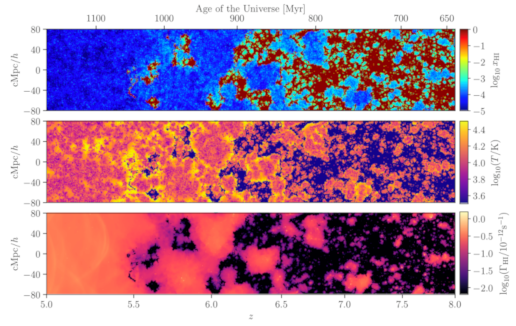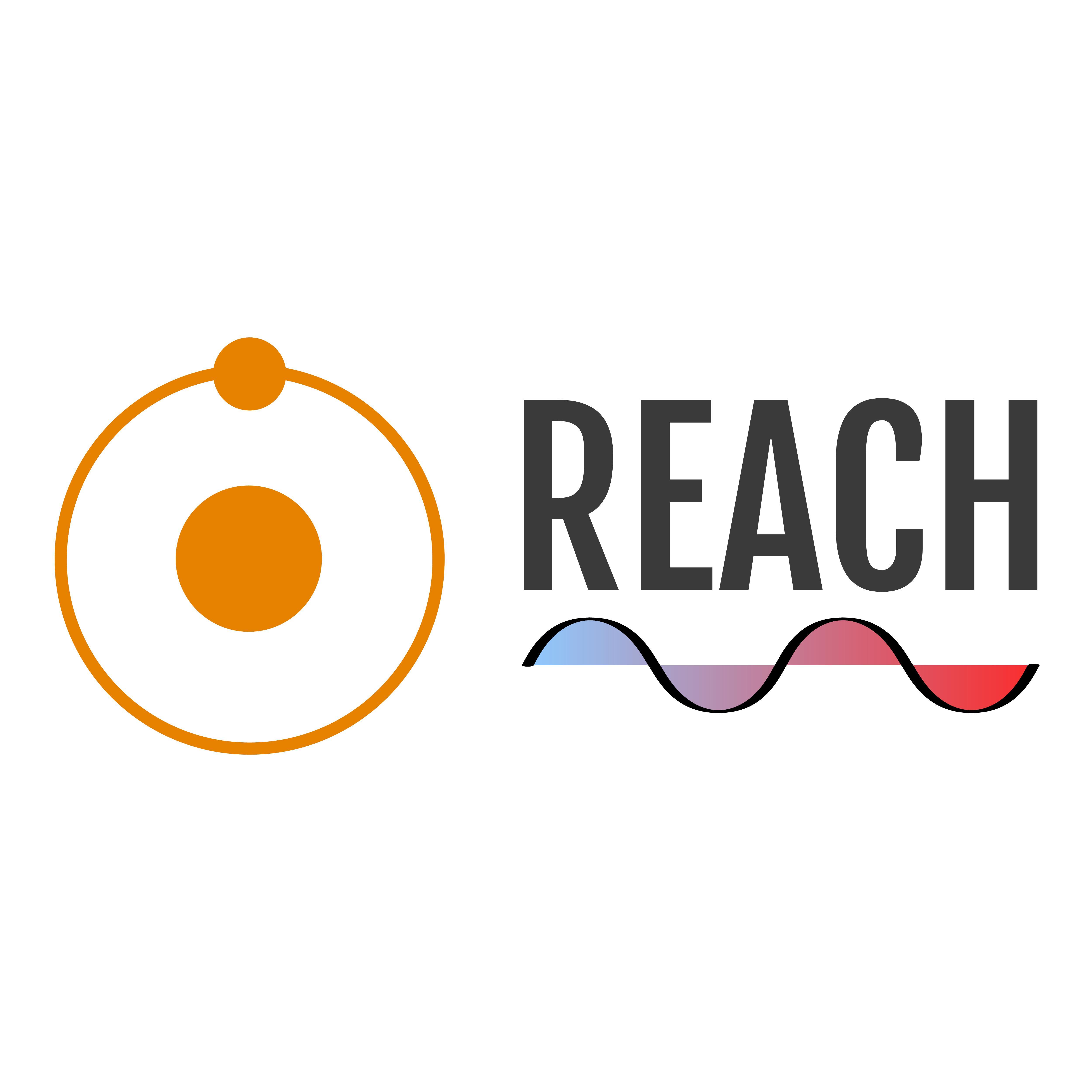In the framework of the hot big bang model, our Universe is expected to become almost neutral around 400,000 years after the big bang. On the other hand, we know from observations of quasar absorption spectra that the same Universe has become highly ionized by the time it is one Gigayear old. The reionization of the Universe is driven by radiation from first luminous sources (galaxies, stars, supermassive accreting black holes). Studying reionization will thus tell us how the first galaxies formed and how they looked like.
There are various ongoing and planned observational projects probing various apsects of reionization. One promising method is to detect the fluctuations in the neutral hydrogen density during the reionization era through its hyperfine transition using facilities like LOFAR, MWA, GMRT, CMA, HERA, SKA, REACH.
Researchers at IoA/KICC are using numerical simulations to study how reionization proceeds. The simulations are used to model the effect of reionization on the absorption spectra and the Lya emission from high-redshift QSOs and galaxies and to generate realistic maps of 21 cm emission arising from the hyperfine transition. The neutral hydrogen distribution before reionization is expected to be complex and patchy and is thus best modelled with numerical simulations. Since very little is known about the detailed physical processes at such early epochs, we have to make different assumptions and then verify the assumptions by comparing with the data. Hence, we generate maps for various scenarios and try to get an idea how to distinguish between them from the data. The figures below illustrate some of this work.
 Figure 1: Radiative transfer simulation calibrated to fit Lya forest data at z<6 based on the Sherwood simulation suite post-processesed with the radiative transfer code ATON (Kulkarni et al. 2018). The top panel shows the neutral hydrogen fraction in a ‘light cone’ stretching from z=5 to z=8. The middle panel shows the temperature of the Intergalactic Medium and the bottom panel shows the hydrogen photo-ionization rate.
Figure 1: Radiative transfer simulation calibrated to fit Lya forest data at z<6 based on the Sherwood simulation suite post-processesed with the radiative transfer code ATON (Kulkarni et al. 2018). The top panel shows the neutral hydrogen fraction in a ‘light cone’ stretching from z=5 to z=8. The middle panel shows the temperature of the Intergalactic Medium and the bottom panel shows the hydrogen photo-ionization rate.

Figure 2: Simulations of the prominent near-zones in high-redshift QSO absorption spectra with the radiative transfer code RADAMESH from Keating et al. (2015). The left panel shows mock absorption spectra for different assumptions of the neutral state of the surrounding IGM while the middle and right panel show the dependence of near-zone size on QSO lifetime and mass of the QSO host halo.

Figure 3: The left panel shows a high-resolution simulation resolving the escape of ionising radiation from galaxies in a simulation with a realistic reionization history. The simulation was performed with the RAMSES-RT code as part of the SPHINX project (Rosdahl et al. 2018). The right two panels show a comparison of CII and OIII observations from the ISM in galaxies during the epoch of reionization with ALMA (Carniani et al. 2017) with our Ramses RT simulations of such galaxies (Katz et al. 2017). Observed and simulated galaxies show similar offsets between CII and OIII emission. In the simulation CII is tracing star forming regions while (some of the) OIII is produced by collisional ionised gas expelled from star forming regions by supernova feedback which causes the spatial offset.

Figure 4: The three light cones on the left contrast the evolution of the 21cm brightness for models where hydrogen reionization is driven by QSOs with models where hydrogen reionization is driven by galaxies for two different reionization histories. The three panels on the right show the evolution of the 21cm power spectrum for the three models (Kulkarni et al. 2017). Note the much larger 21cm signal in the model where reionization is driven by QSOs (solid coloured curves, galaxies are in black) that should soon be in reach of LOFAR, HERA and perhaps MWA.
Through the tight links with the Battcock Centre for Experimental Astrophysics, research in this area at KICC is tightly linked to major 21cm reionization projects such as HERA and SKA.
Recently, the KICC funded and help initiate REACH (Radio Experiment for the Analysis of Cosmic Hydrogen). REACH is an international collaboration led by Cambridge with members from Cavendish Astrophysics, KICC and the IoA. REACH's unique approach is to detect and study the Global 21-cm signal from the Cosmic Dawn and the Epoch of Re-ionization by jointly fitting physics-rooted models of the cosmological signal, foregrounds and instrument in a Bayesian framework. The instrument is being deployed in the radio quiet region of the Karoo in South Africa, home of the future SKA1-Mid radio telescope and the HERA telescope, amongst other instruments. If you are interested in doing research in REACH and experimental radio cosmology (eg. HERA), please follow this link.

Figure 5: The REACH experiment is in development and aiming at deployment and early commissioning in 2021.
People involved in this area are:
- Martin Haehnelt
- Anastasia Fialkov
- Prakash Gaikwad
- Richard McMahon
- Ewald Puchwein
- Lewis Weinberger
- Eloy de Lera Acedo
References
Carniani et al. , 2017, A&A, 605, 42
Katz et al., 2017, MNRAS, 468, 4831
Keating L. C., Haehnelt M.G., Cantalupo S., Puchwein E., 2015, MNRAS, 454, 681
Kulkarni G., Keating L.C., Haehnelt M.G., Bosman S E.I.,Puchwein E., Chardin J., Aubert D., submitted to MNRAS, arXiv1809.0637
Kulkarni G., Choudhury T. R., Puchwein E., Haehnelt M.G., 2017, MNRAS, 469, 4283
Rosdahl J.et al. , 2018, arXiv:180107259


